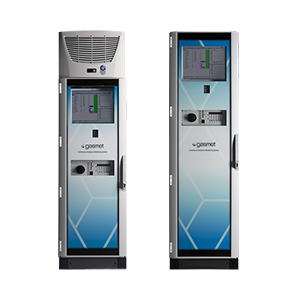NOx, NH3 and N2O emissions
Nitric acid is most commonly produced by Ostwald process. The process converts ammonia to nitric acid in two steps. During the first step ammonia is oxidized to form nitric oxide (NO) and nitrogen dioxide (NO2). During the second step, the nitrogen dioxide that was formed is absorbed in water. This, in turn, forms nitric acid. During this process NOx, NH3 and N2O emissions are produced.
Nitrogen oxides and ammonia are harmful to the environment and toxic to humans. Nitrogen oxides are a group of seven gases and compounds composed of nitrogen and oxygen. The two most common and hazardous nitrogen oxides are nitric oxide and nitrogen dioxide. Ammonia on the other hand is a compound of nitrogen and hydrogen.
Nitrous oxide, commonly called laughing gas, is a strong greenhouse gas that contributes to climate change.
Emission Abatement
The ability to detect and measure almost any gas (including NOx, NH3 and N2O), combined with the robustness and reliability of the technology, makes Fourier Transform Infrared (FTIR) spectroscopy ideal for the continuous measurement of these emissions.
These measurements can be used to control and develop processes and emissions abatement systems. An example of a process that can be developed is the process of NOx reduction, or DeNOx. Through more efficient processes and optimally operating emissions abatement systems harmful emissions and greenhouse gases can be reduced.

Our Solutions: Continuous Monitoring System and Portable Gas Analyzer
Gasmet manufactures portable FTIR gas analyzers and stationary FTIR emissions monitoring systems for chemicals industry. An FTIR analyzer works by simultaneously scanning an entire infrared spectrum. Our Calcmet software then calculates the concentrations of each gas in the sample based on the characteristic absorption. All the gases in the sample can be measured simultaneously because the entire infrared spectrum is scanned at once. This allows very quick multi-component measurements and compensation for any cross-interference.
- The Continuous Emissions Monitoring System CEMS II e offers TÜV and MCERTS certified solution (QAL1) for a wide range of demanding emission monitoring applications. The CEMS II e system utilizes Fourier Transform Infrared Spectroscopy FTIR technology.
- GT6000 Mobilis can be used when you need a portable gas analyzer solution instead of continuous gas monitoring. It is a portable FTIR gas analyzer for applications where multiple gas compounds need to be accurately monitored in hot & humid sample gas. Gasmet GT6000 Mobilis is the world’s smallest FTIR emissions monitoring system.
Why choose Gasmet as your emissions monitoring partner?
Gasmet is an ideal partner for the chemical industry. Here are the top 5 reasons why you should choose us as your partner:
- Multicomponent capability – measure multiple gases simultaneously
- Adding new gases is easy – no need for hardware changes
- Emission monitoring systems are available with performance approvals (TÜV, MCERTS)
- A portable FTIR analyzer allows you to take the lab to the site
- Simple and low-cost calibration – Gasmet’s analyzers do not need any span or re-calibrations, only zero calibration with nitrogen needed
CEMS II – Reliable emissions monitoring
We built CEMS II, so that emission monitoring would not need to keep you awake at night. That you would never need to wonder whether your emission monitoring equipment will meet the standards and requirements of tomorrow.
GT6000 Mobilis – Effortless stack testing
We built GT6000 Mobilis, so that for most of your stack testing gigs you would only need one compact analyzer to do the job. So that you could view results on your tablet in real-time, and wouldn’t need to stop by the lab on your way home.



